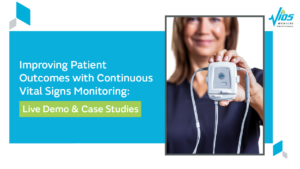
Revolutionizing Patient Transitions: The Vital Role of Monitoring Systems for Discharge Planners
Revolutionizing Patient Transitions: The Vital Role of Discharge Planners
Discharge planners play a crucial role in ensuring a smooth transition from hospitals to skilled nursing facilities (SNFs) and beyond. They ensure patients’ needs will be met post discharge and enables them to function at optimal levels once they return home.1 Unfortunately, of the 1.5 million patients discharged each year to post-acute care facilities, 25% are either readmitted to acute care or die within 30 days.2
Proactively Monitoring Patients Can Reduce Readmissions
Many adverse patient events can be prevented — in fact, 78% of hospital readmissions are considered ‘avoidable’.3 Without the right tools in place, discharge planners and their partner post-acute care facilities will continue to have residents readmitted in critical conditions.
By implementing real-time continuous vital signs monitoring solutions, like the Vios Monitoring System, clinicians can be notified when predetermined conditions are reached and signs of deterioration are exhibited in a patient. Which, in turn, enhances safety and proactively avoids 30-day readmissions. A study found that, continuous monitoring of patient vital signs using wearable monitoring technology linked wirelessly to hospital systems was associated with a reduction in unplanned ICU admissions.4
Vital signs and comprehensive reports generated by the Vios Monitoring System are seamlessly uploaded into the Electronic Medical Record (EMR). This integration provides care teams and healthcare providers with a holistic view of patient health. Access to real-time data empowers healthcare teams to make informed and timely decisions, promoting patient safety and reducing the risk of adverse events.
Elevating Care Through Improved Communication
Effective communication between hospitals and post-acute healthcare facilities is key to a successful discharge process. The discharge planning process involves an interprofessional team approach which requires alignment on all fronts to optimize patient care. It is critical to communicate the plan amongst the necessary providers and patient. By communicating the discharge plan effectively to the patient, the provider can directly impact the quality of care that a patient receives.5
The Vios Monitoring System offers remote access to caregivers, facilitating real-time assessments, optimal clinical decision-making, and care coordination. Improved communication around resident health and status empowers the staff to provide better, more efficient, and proactive care.
Navigating Staffing Shortages
Staffing shortages across healthcare institutions have forced most facilities to reduce new admissions and rely on overtime shifts and pricey agency hires to maintain operations. The Vios Monitoring System, when coupled with Remote Monitoring Services (RMS), becomes an extension of an on-site Care Team. You can be assured that someone is “always watching” a patient when a caregiver is not in the room. Clinical staff know their patients are being monitored as they care for their total patient assignment. The Vios Remote Monitor Technicians remove the oversight and alarm burden from the clinical teams to ensure utilization and integration into clinical practice.
Towards More Confident Discharge Planning
Integration of continuous vital signs monitoring systems at post-acute care facilities can transform discharge planning into a more confident and efficient process. It can lead to increased communication across care teams, reduced readmissions through event notifications, and improved clinical oversight. Discharge planners coupled with the Vios Monitoring System can pave the way to a more simplified, patient-centric process.
Contact Us Today!
-
-
- Mamon J, Steinwachs DM, Fahey M, Bone LR, Oktay J, Klein L. Impact of hospital discharge planning on meeting patient needs after returning home. Health Serv Res. 1992 Jun;27(2):155-75. PMID: 1317367; PMCID: PMC1069871.
- Ryskina, K.L., Foley, K.A., Karlawish, J.H., Uy, J.D., Lott, B., Goldberg, E., Hodgson, N.A. (2020). Expectations and experiences with physician care among patients receiving post-acute care in US skilled nursing facilities. BMC Geriatrics 20(463).
- The Skilled Nursing Facility 30-Day All Cause Readmission: What’s Next? (April 1, 2021). HealthStream. https://www.healthstream.com/resource/blog/the-skilled-nursing-facility-30-day-all-cause-readmission-what-s-next
- Eddahchouri, Yassin, et al. “Effect of Continuous Wireless Vital Sign Monitoring on UNPLANNED ICU …” Effect of Continuous Wireless Vital Sign Monitoring on Unplanned ICU Admissions and Rapid Response Team Calls: A before-and-after Study, British Jornal of Anaesthesia, 11 Mar. 2022, www.bjanaesthesia.org/article/S0007-0912(22)00073-3/fulltext.
- Burton LC, Anderson GF, Kues IW. Using electronic health records to help coordinate care. Milbank Q. 2004;82(3):457-81, table of contents. [PMC free article] [PubMed]
-



